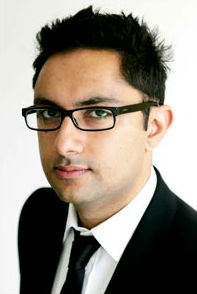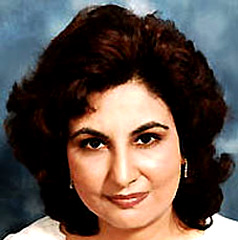
Q. Tell us about your debut novel, Marriage Material and what inspired you to write this story?
I guess the idea came together in 2011, during the riots, which affected Wolverhampton as well as London. I remember watching David Starkey, the historian, on Newsnight, feverishly blaming the riots on “a violent, destructive and nihilistic” black culture, and citing Enoch Powell’s 1968 Rivers of Blood Speech, saying that the riots proved that Powell was right about immigration. People sometimes forget that Powell was a Wolverhampton MP, and if you re-read his famous speech you will find that one of Powell’s targets was the policy of “integration” which he described as a dangerous delusion, unacceptable even to immigrants such as the Sikhs, who were campaigning at the time for the right to wear turbans and beards while working on Wolverhampton buses. Having done lots of research for my last book into what Wolverhampton was like in 1968, I thought it would be great to write a family story which traced the story of Sikh immigrants from 1968 all the way to the riots of 2011. And Arnold Bennett’s 1908 novel, The Old Wives’ Tale, which is set in a drapery shop in Stoke, provided a great structure. It is set around one family in a shop in the Midlands between around 1850 and 1910. Mine is set around a family in a Wolverhampton shop between around 1960 and 2012. They are, in the end, very different books, but I would like to think both say something important about Britain.
Q. The story primarily follows three generations of the Bains’ family in Wolverhampton and their cornershop. Did you draw on your own family experiences, growing up in Wolverhampton – and how much of you is there in Arjan?
The problem with writing a memoir like my last book, quite an intimate one in my case, is that you end up invading your own privacy. I was very careful about what I said about my family – nothing appeared without their permission. But I didn’t think enough about what I revealed about myself. And I probably revealed too much. In a way, writing this new book, a piece of fiction, was a way of changing the subject, to stop people asking me personal questions, or at least have something else to say. But while writing it I realised the questions would never stop – people would continue to think it is about me. So I have tried to be post-modern about it… the narrator seems to be me, but is also obviously inspired by a Bennett character too. At the risk of sounding like of Literature student – I wanted to raise questions about truth, and play a meta-fictional game with it. I hope it works.
Q. I loved your first book, The Boy with a Topknot, which was of course a memoir. How did the writing of Marriage Material differ to your first book and what was the challenges you faced when writing fiction?
Well, the biggest challenge of book one was the emotional trauma associated with the subject matter. It was nice to be free of that! But book two felt quite similar to write, technically speaking, as there is so much fact in it – a lot of research into how shops have changed over 50 odds years, the politics and so on. I see it as historical fiction really, which isn’t massively removed from memoir, as a form.
Q. You mention in the acknowledgements that this book is a reworking of Bennett’s Old Wives Tale – how did this come about and was it simply a case of borrowing a good idea and making it your own?
My friend Lottie Moggach gave me the Penguin Classics edition of this book and the truth is that I never got around to reading it. The appeal of “classics” rather gets knocked out of you when you study English Literature at university. There always seemed to be better things to do than tackle 615 pages by a writer better known for an omelette than for his work. In the end, I read the Kindle edition. And only because I had a long flight to India, it was free to download, and I had run out of other things to read. But it was a revelation to discover that the story, published in 1908 and about the lives of two sisters growing up in a drapery shop in the Potteries, felt more relevant than any of the free newspapers dished out in economy. This is in large part down to the universality of Bennett’s themes: in particular, the generation gap (the agony of an older generation watching the rise of the younger); the clash between the provincial and the metropolitan (Bennett contrasts Sophia’s life in Paris where she escapes with her lover, with that of her sister Constance in Bursley); and the threat small communities face from industrialisation (his concern about the survival of the small shop echoes now). But I was struck even more by the parallels between the world he describes and my own background as the child of Punjabi immigrants to the West Midlands. Life in the Potteries in Victorian times was hard and dangerous: just as life was for immigrants arriving to toil in Black Country factories in the 1950s and 1960s. Bennett’s characters were obsessed with the acquisition of money and social status, in the same way that Punjabi Sikh culture fetishises wealth over education. Then there is the novel’s presiding concern with marriage. Surreally, “Baines”, with the vowel dropped, is even a common Sikh surname. Finishing the book in Delhi, it struck me that the structure of The Old Wives’ Tale could inspire a TV series about a Punjabi family, with the story moved forward a century from (roughly) 1840 to 1905 to (roughly) 1940 to 2005, the setting dragged 34 miles south from the Potteries to the West Midlands, and the characters based in an Asian corner shop instead of a Victorian draper’s shop. Not knowing where to begin with a script, this idea gradually morphed into Marriage Material. I would love it if my homage inspired people to give Bennett a chance. My book is meant to be a conversation with Bennett… I like the idea of the form echoing the old complaint about immigrants “coming over here and taking over”.
Q. It’s rare for us as readers to be in the company of a Punjabi family – so much of it is new to me, but also familiar. Why do you think that there is a shortage of books that centre or shed light on Punjabi culture?
Punjabi culture is fundamentally non-literary… or oral. People don’t read books much. And education is seen primarily as a way of improving one’s employment prospects and making money. But you could say the same about the communities that Bennett was writing about in 1908. And there are many parallels between Punjabi culture and Jewish culture, and Catholic culture… which is good, as a writer you want to aim for the universal.
Q. It’s clever and funny writing but you deal with so much, as with your previous work, with really serious issues about race and racism, family and identity as well as independence and inter-dependence as part of those complicated and messy family dynamics with a light touch, but as the same time being careful to be truthful but also with a great deal of compassion. How did you master this sort of writing or is it a case of not over-thinking when writing?
It’s not a conscious thing. But I guess a lot of writing coming out of the Midlands, from the likes of Jonathan Coe, Catherine O’Flynn and David Lodge is comic in tendency. A lot of Punjabi products, from Goodness Gracious Me to Bend It Like Beckham, are funny too. And the writers I like most, from Evelyn Waugh to William Boyd have elements of humour.
Q. Your portrayal of modern Asian men is quite damning – you have Arjan on the one hand, who is educated and purposeful but is spineless at times and afraid of his mother. On the flip side you have Ranjit, who is his polar opposite but is a pathetic loser. Do you think this is true reflection of how the Asian man (particularly the second and third generations) is today?
Totally disagree! The thing about human beings is that they are complex, and whatever you say about someone, you can usually say the opposite too. I would say Arjan is those things, but he is also dedicated and thoughtful and has great moral purpose. And as for Ranjit, he is pathetic in some ways, but also charismatic and funny. I like and dislike bits of both of them.
Q. An easier question: Were you at any point tempted to call this book The Boy in a Sweet Shop?
Ha. No. But I did consider calling it: My Mother Was Right. As a lot of my views of marriage have changed over the last decade.
Q. I love the fact that this story centres around the lives of ordinary people in an ordinary place. Do you think you’re helping to set a trend among young British Asian writers to write about the places they grew up, rather than their imagined homelands that have never been home (and are obviously more mysterious and more romanticised than Wolverhampton, Mumbai for example.)
I have no sense of influencing anyone! But I admire writers who write realistically about life, from Arnold Bennett to William Trevor, Junot Diaz, Hari Kunzru and Nikesh Shukla.
Q. Finally what’s next for you as a writer?
Not sure. Have an idea for another book, but have one for a script too, and am enjoying journalism massively. Let’s see….
Sathnam Sanghera was born in 1976. He is an award-winning writer for The Times. His first book, The Boy with the Topknot: A Memoir of Love, Secrets and Lies in Wolverhampton, was shortlisted for the 2008 Costa Biography Award and the 2009 PEN/Ackerley Prize and named 2009 Mind Book of the Year. Marriage Material is his first novel and is out now.
